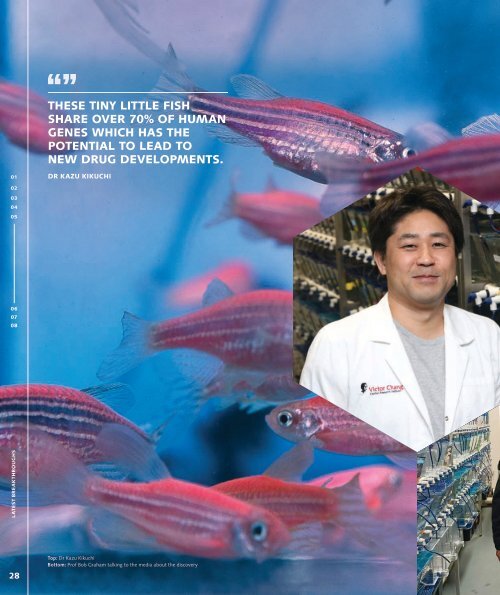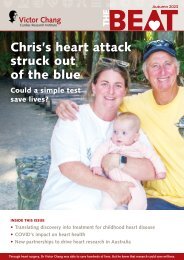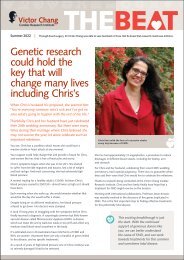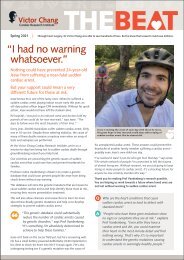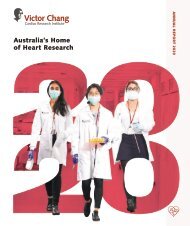Victor Chang Cardiac Research Institute 2021 Annual Report
The 2021 Victor Chang Cardiac Research Institute Annual Report is an edition reflecting on the year that was - a year where the Institute is laying the foundations and reinforcing their voice as the leaders in cardiovascular translational research across Australia.
The 2021 Victor Chang Cardiac Research Institute Annual Report is an edition reflecting on the year that was - a year where the Institute is laying the foundations and reinforcing their voice as the leaders in cardiovascular translational research across Australia.
You also want an ePaper? Increase the reach of your titles
YUMPU automatically turns print PDFs into web optimized ePapers that Google loves.
THESE TINY LITTLE FISH<br />
SHARE OVER 70% OF HUMAN<br />
GENES WHICH HAS THE<br />
POTENTIAL TO LEAD TO<br />
NEW DRUG DEVELOPMENTS.<br />
UNCOVERING<br />
A SECRET<br />
SWITCH<br />
01<br />
DR KAZU KIKUCHI<br />
02<br />
03<br />
04<br />
05<br />
A critical new gene has been discovered that could<br />
help repair damaged heart muscle after a heart attack.<br />
06<br />
07<br />
08<br />
<strong>Research</strong>ers at the <strong>Institute</strong> identified<br />
a genetic switch in zebrafish that<br />
turns on cells allowing them to<br />
divide and multiply after a heart<br />
attack, resulting in the complete<br />
regeneration and healing of damaged<br />
heart muscle in these fish.<br />
It’s already known that zebrafish<br />
can heal their hearts, but research<br />
published in Science revealed<br />
for the first time the role played<br />
by a critical gene called Klf1.<br />
HOW THE GENE WORKS<br />
NEXT STEPS<br />
The next steps are to undertake further<br />
research into the gene’s function to<br />
see if it may also act as a switch in<br />
human hearts and improve the ability<br />
to pump blood around the body.<br />
The discovery was made in<br />
collaboration with the Garvan<br />
<strong>Institute</strong> of Medical <strong>Research</strong>.<br />
LATEST BREAKTHROUGHS<br />
The gene makes remaining uninjured<br />
heart muscle cells more immature<br />
and changes their metabolic wiring.<br />
This allows them to divide and make<br />
new cells. When the gene is removed,<br />
the zebrafish heart loses its ability<br />
to repair itself after an injury such<br />
as a heart attack, which pinpoints<br />
it as a crucial self-healing tool.<br />
Dr Kazu Kikuchi, who led this worldfirst<br />
research whilst at the <strong>Institute</strong>,<br />
says: “We identified a secret switch<br />
that allows heart muscle cells to divide<br />
and multiply after the heart is injured.<br />
It kicks in when needed and turns<br />
off when the heart is fully healed.<br />
In humans where damaged and<br />
scarred heart muscle cannot replace<br />
itself, this could be transformative.”<br />
victorchang.edu.au<br />
28<br />
Top: Dr Kazu Kikuchi<br />
Bottom: Prof Bob Graham talking to the media about the discovery<br />
Far left: Zebra fish<br />
Top: Professor Bob Graham<br />
Bottom: Dr Kazu Kikuchi<br />
29


